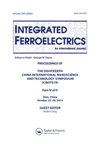Glass-Ceramic Na 3+x [(Zr/Cr) x (Sc/Ti) 2-x (PO 4 ) 3 Electrolyte Materials for Na-Ion Full-Cell Application
IF 0.7
4区 工程技术
Q4 ENGINEERING, ELECTRICAL & ELECTRONIC
引用次数: 0
Abstract
AbstractNa3+x[(Zr/Cr)x(Sc/Ti)2-x(PO4)3] glass-ceramic material compositions containing NASICON-type crystalline phases might be a good candidate as an efficient electrolyte exclusively for Na-ion batteries. All-solid-state Na-ion full cells are designed with the three-layered pellets (NaCo0.7(VO)0.3PO4/Na3.5Zr0.5Sc1.5(PO4)3 (NZSP) and Na3.5Cr0.5Ti1.5(PO4)3) (NCTP)/Na-metal foil). The electrical conductivity of the NZSPglass-ceramic powder sample achieves to be highest (9.47 × 10−04 S/cm) due to its lower grain boundary resistance (Rgb) as observed in SEM images and also exhibits best electrochemical stability against conductivity when the samples kept in ambient air for 60 d. The charge/discharge capacities for the initial cycle are 75/69 and 60/53 mAhg−1 to both NZSP and NCTP of two full cells, respectively. However, discharge capacities are boosted up for both these cells without much loss in coulombic efficiency even after 10 cycles.Keywords: Sodium-ion batteryglass-ceramic solid electrolyteNASICON phasecyclic performance AcknowledgmentsThe authors wish to thank Dr. Tanusrivathava, Scientist, DMRL Hyderabad, for helping us to carry out SEM images.Disclosure StatementNo potential conflict of interest was reported by the author(s).钠离子全电池用玻璃陶瓷Na 3+x [(Zr/Cr) x (Sc/Ti) 2-x (po4) 3]电解质材料
摘要含nasiconon型晶相的na3 +x[(Zr/Cr)x(Sc/Ti)2-x(PO4)3]玻璃陶瓷材料组合物可能是钠离子电池专用的高效电解质的良好候选材料。采用三层微球(NaCo0.7(VO)0.3PO4/Na3.5Zr0.5Sc1.5(PO4)3 (NZSP)和Na3.5Cr0.5Ti1.5(PO4)3) (ntp)/ na金属箔)设计全固态钠离子电池。SEM图像显示,由于具有较低的晶界电阻(Rgb), NZSP玻璃陶瓷粉末样品的电导率达到最高(9.47 × 10−04 S/cm),并且当样品在环境空气中保存60 d时,其电导率也表现出最佳的电化学稳定性。对于两个充满电池的NZSP和NCTP,初始循环的充放电容量分别为75/69和60/53 mAhg−1。然而,即使在10次循环后,这两种电池的放电容量都得到了提高,而库仑效率也没有很大的损失。关键词:钠离子电池,玻璃陶瓷固体电解质,asicon相循环性能致谢作者要感谢Tanusrivathava博士,科学家,DMRL Hyderabad,帮助我们进行SEM图像。披露声明作者未报告潜在的利益冲突。
本文章由计算机程序翻译,如有差异,请以英文原文为准。
求助全文
约1分钟内获得全文
求助全文
来源期刊

Integrated Ferroelectrics
工程技术-工程:电子与电气
CiteScore
1.40
自引率
0.00%
发文量
179
审稿时长
3 months
期刊介绍:
Integrated Ferroelectrics provides an international, interdisciplinary forum for electronic engineers and physicists as well as process and systems engineers, ceramicists, and chemists who are involved in research, design, development, manufacturing and utilization of integrated ferroelectric devices. Such devices unite ferroelectric films and semiconductor integrated circuit chips. The result is a new family of electronic devices, which combine the unique nonvolatile memory, pyroelectric, piezoelectric, photorefractive, radiation-hard, acoustic and/or dielectric properties of ferroelectric materials with the dynamic memory, logic and/or amplification properties and miniaturization and low-cost advantages of semiconductor i.c. technology.
 求助内容:
求助内容: 应助结果提醒方式:
应助结果提醒方式:


